Introduction
As summer break ends, it’s time to prepare you (and your house) for the upcoming school year. The transition from lazy summer days to structured school routines can be challenging for both parents and children. However, with careful planning and preparation, you can create a smooth and stress-free start to the school year. In this article, we will guide you through the process of getting your home ready for back-to-school.
From decluttering and organizing to establishing routines and creating a study area, we will cover all the back-to-school tips and some helpful tools to help ensure a successful school year for your family. For many school districts (hopefully), we are back to in-person learning (please, no more remote learning).

We’re on our 5th year of this rigamarole so, although we wouldn’t consider ourselves to be experts; hopefully, we can offer a few tips in order to get ready for back to school to make sure your child thrives as the school bell rings in the first day of class.
Affiliate Disclosure: As a disclaimer, please note that some of the links included in this article are affiliate links. This means that if you click on one of these links and make a purchase, we may receive a small commission at no extra cost to you. We only recommend products or services that we believe can add value to our readers. Your support through these links is greatly appreciated and helps us to keep creating helpful content. As an Amazon Associate and affiliate, I earn from qualifying purchases.
Tip 1: Decluttering and Organizing
Before school begins, it’s essential to declutter and organize your home. A clutter-free environment promotes a calm and focused mindset, benefiting both parents and children. Start by tackling one room at a time, sorting items into three categories: keep, donate, and discard.
Encourage your children to participate in the process, teaching them the importance of organization and responsibility. By involving them, you not only lighten your workload but also empower them to take ownership of their belongings.
Once you have decluttered, it’s time to organize. Invest in storage solutions such as bins, baskets, and shelves to create designated spaces for school supplies, books, and backpacks. Label each container to ensure everything has its place.
Additionally, establish a system for paperwork, such as setting up a file organizer or a bulletin board where you can display important school documents, permission slips, and schedules. By decluttering and organizing your home, you not only create a more peaceful environment but also set the stage for a productive school year.
Tackling the Mud Room
I finally got the courage to tackle our mud room to prepare for our back to school journey, and it has immensely helped our morning routine as we send the kids off to school. The room between our garage and living space (our mud room) was the dumping ground for EVERYTHING that entered our house and seemingly disappeared into the abyss, only to be tripped over later.
I first started the overwhelming task by completely clearing everything out. Hey, things have to get worse before they can get better. I then proceeded to separate all the things into “Keep,” “Donate,” “Sell,” and “Trash” piles.
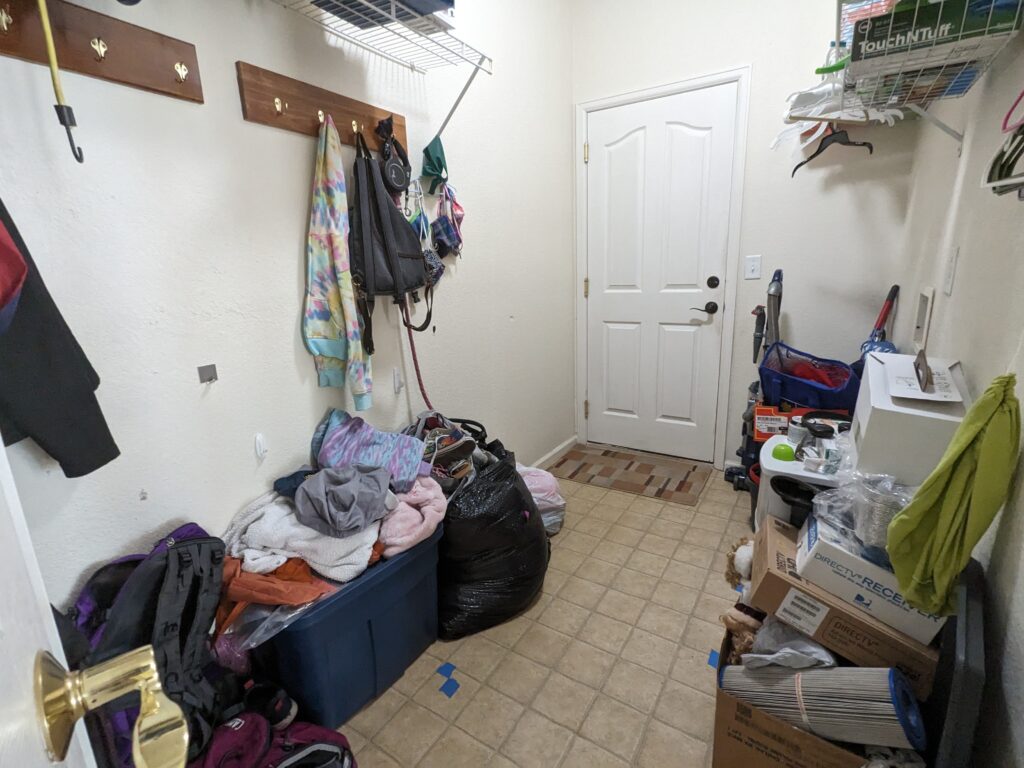

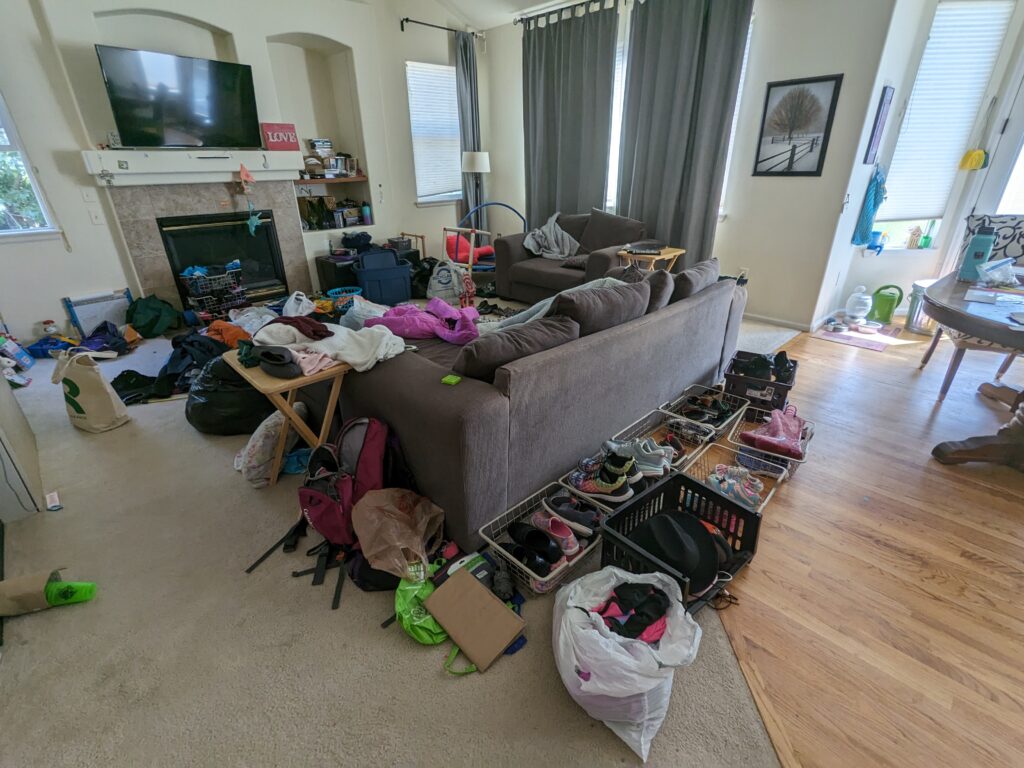
From there, I went through old coats and shoes and mismatched gloves and finally got rid of those adorable tiny infant shoes that my almost 9-year-old’s toes clearly won’t fit in anymore, and I purged. A LOT. More isn’t always better, and purging is a great way to make that back to school transition easier.
Purging and organizing is a great way to prepare for the back to school season. I’ve found that it has helped immensely with the kid’s attitudes and mental state in the morning and made the transition to starting school much more enjoyable.
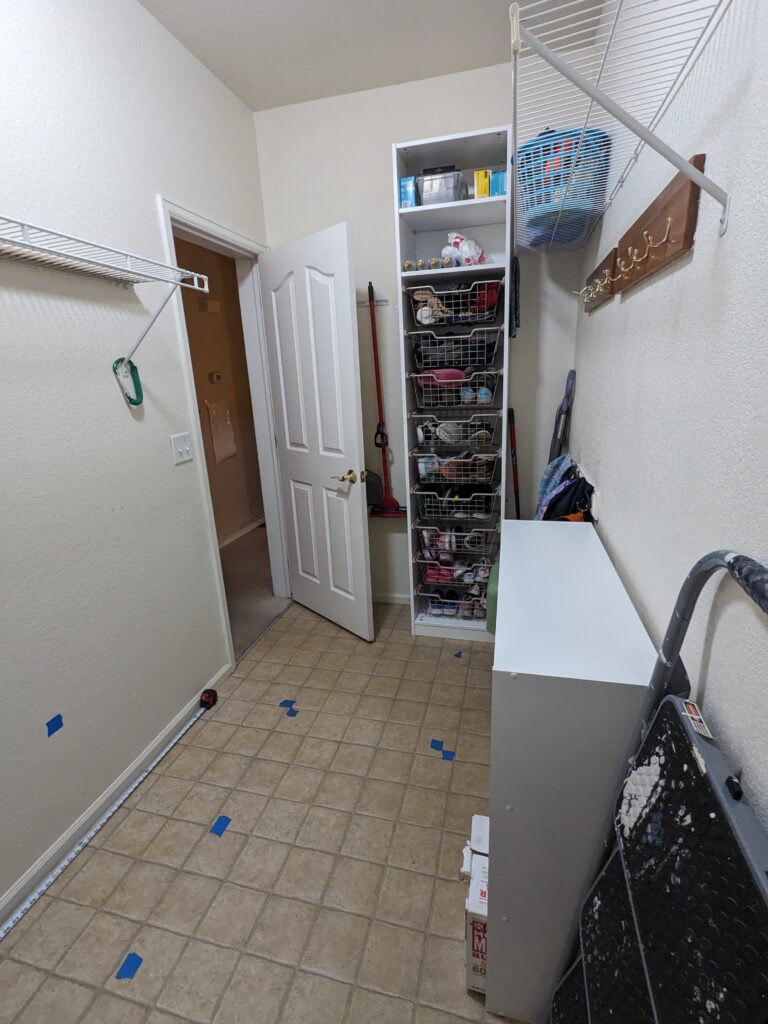
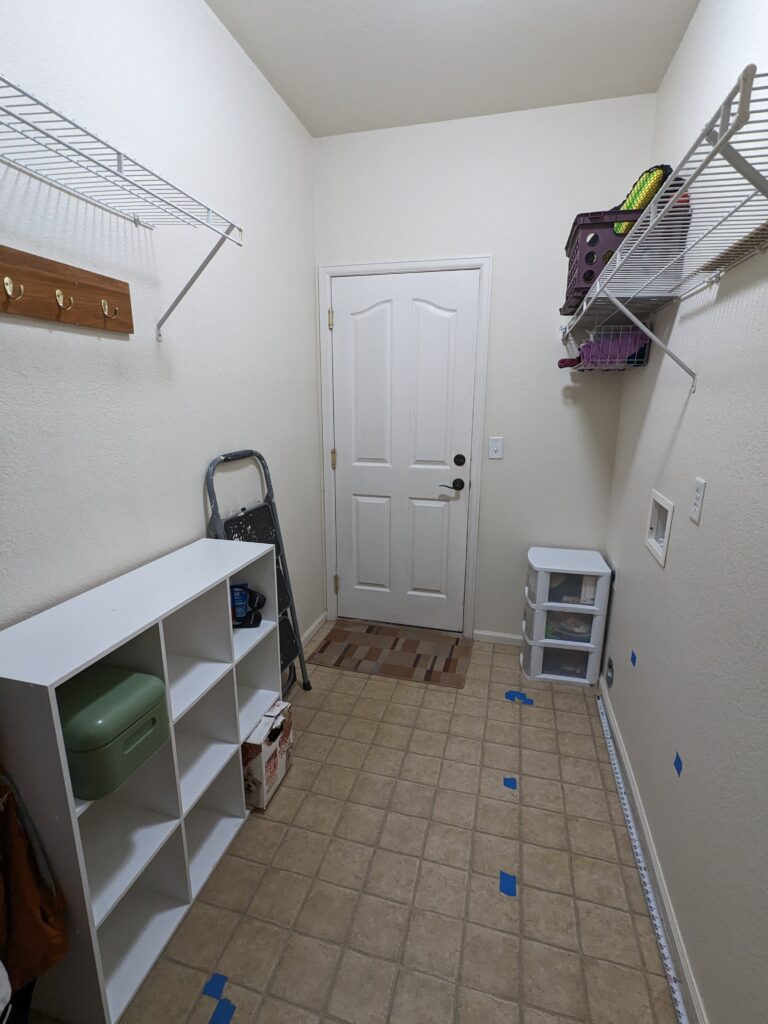
Once I widdled the shoe bins and coat piles down to what actually fit and filled a few hefty bags worth of Goodwill items, I was able to start reorganizing the necessities. I swiped a shelf that had been in my son’s room collecting dust and junk for years and then used my Facebook Marketplace skills to score an awesome single-row cube shelf to use as a bench.
Wam bam, 24 hours (and a sore back) later, we have a functional space that makes the back to school rush less crazy. It’s not perfect, and it’s not the picture-perfect mudroom you’ll find in magazines and Pinterest, but it wasn’t in our budget to overhaul the mudroom this year so for now, this works for us. They have everything they’ll need for the start of school in one spot, and when the kids get home from school can go back where it belongs so they’re ready for the next day.
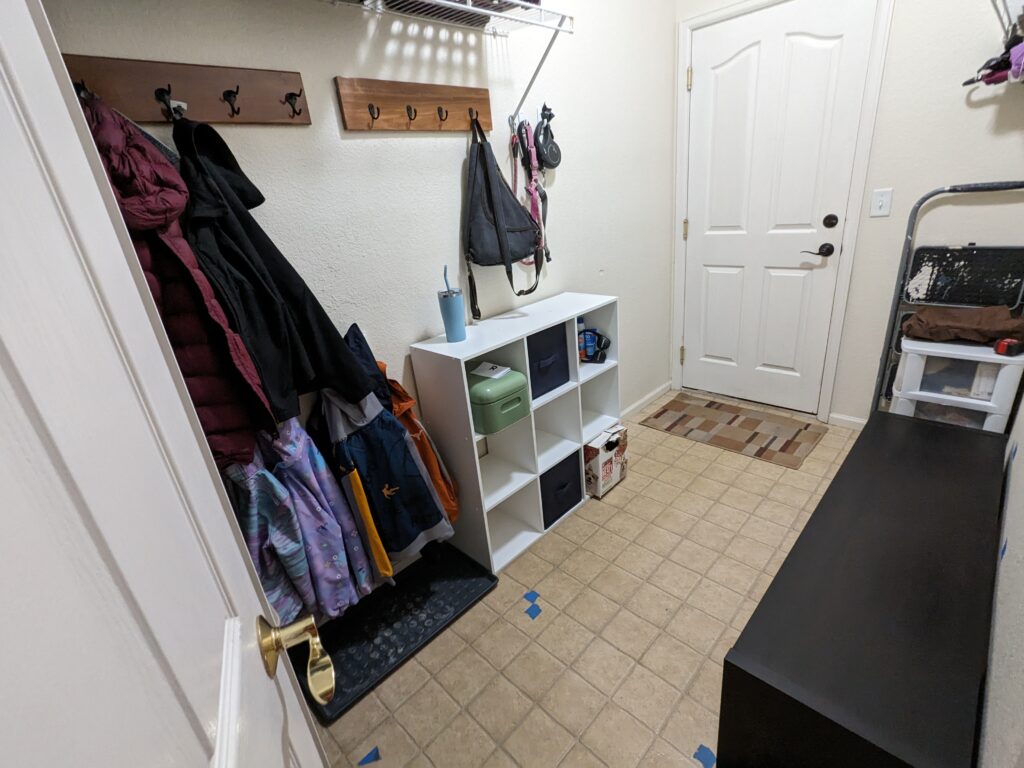
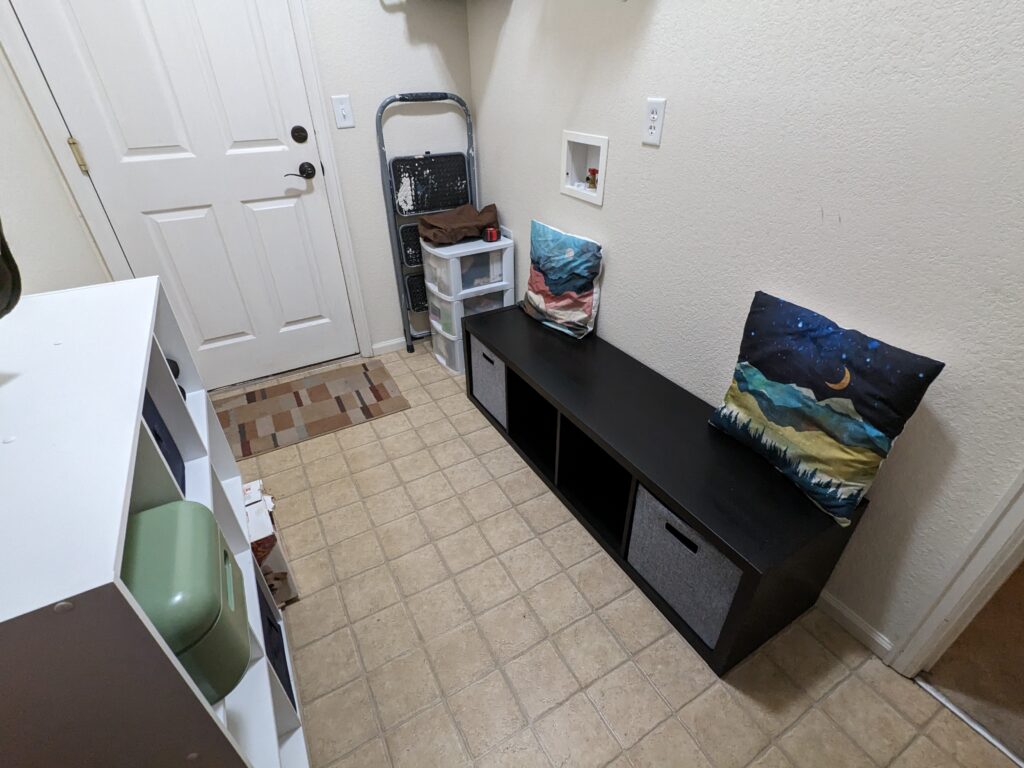
Furthermore, involve your children in the process of organizing their own spaces, such as their bedrooms and study areas. By giving them the responsibility to keep their areas tidy, you teach them valuable life skills and foster a sense of independence. Encourage them to create their own systems, such as color-coded folders or labeled drawers, to keep their school supplies and materials organized. By involving your children in the decluttering and organizing process, you empower them to take charge of their own spaces and develop important life skills.
Check out other tips on Renovating on a budget here.
Tip 2: Creating a Homework and Study Station
A designated study area plays a crucial role in fostering good study habits and concentration. Find a quiet and well-lit area in your home where your children can focus on their schoolwork without distractions. This could be a corner of their bedroom, a dedicated space in the living room, or even a small desk in the hallway.
When setting up the study area, ensure it is free from distractions such as toys, electronics, or excessive noise. Ensure that the homework station is well-stocked with essential school supplies. Keep items like pencils, pens, erasers, rulers, and calculators within easy reach. Consider creating a supply caddy or a drawer organizer to keep everything organized and easily accessible.
By having a well-equipped homework station, you eliminate the need for your children to search for supplies, maximizing their productivity and focus during homework time. Consider adding a comfortable chair and a small bookshelf for easy access to reference materials.
Furthermore, create a visual timetable or a to-do list that your children can refer to while studying. This helps them stay organized and manage their time effectively. Encourage them to break down their assignments into smaller tasks and set achievable goals. By creating a dedicated study area and providing the necessary tools, you create an environment that promotes focus and productivity.
We came across these handy folding tables at IKEA in the Ivar Collection at the start of Covid, so our kids could have their own workspace and not kill each other during distance learning, and they continue to be so useful as they advance through school! They fold up with not in use (which is rare at our house) and hold a ton of stuff!
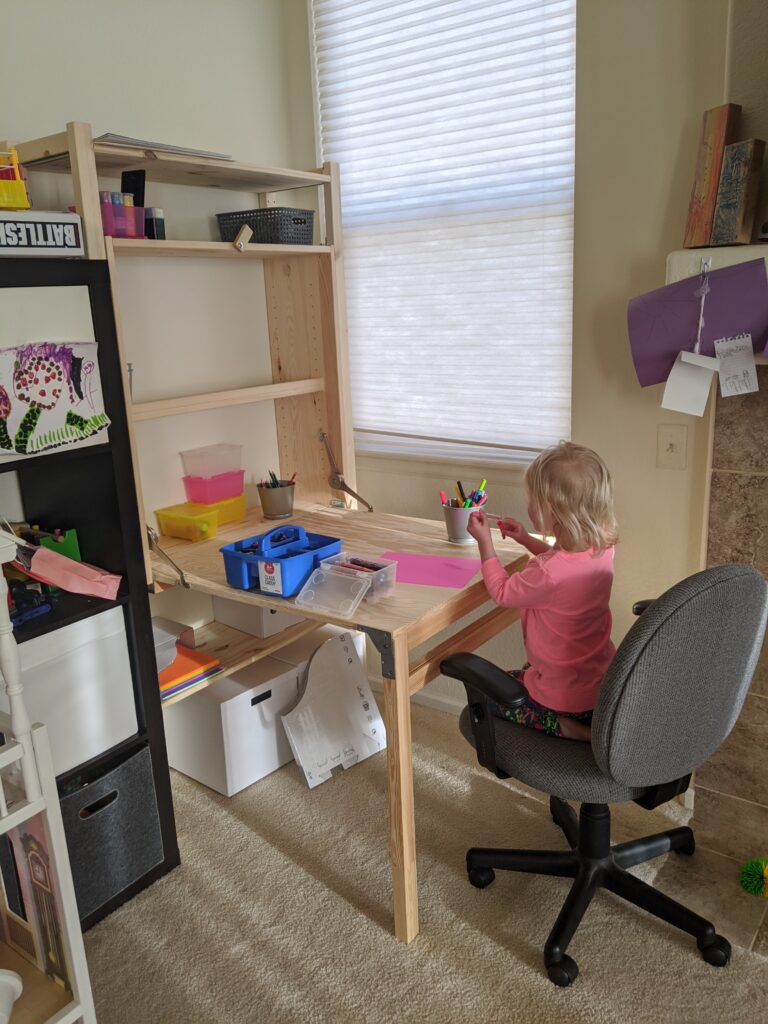
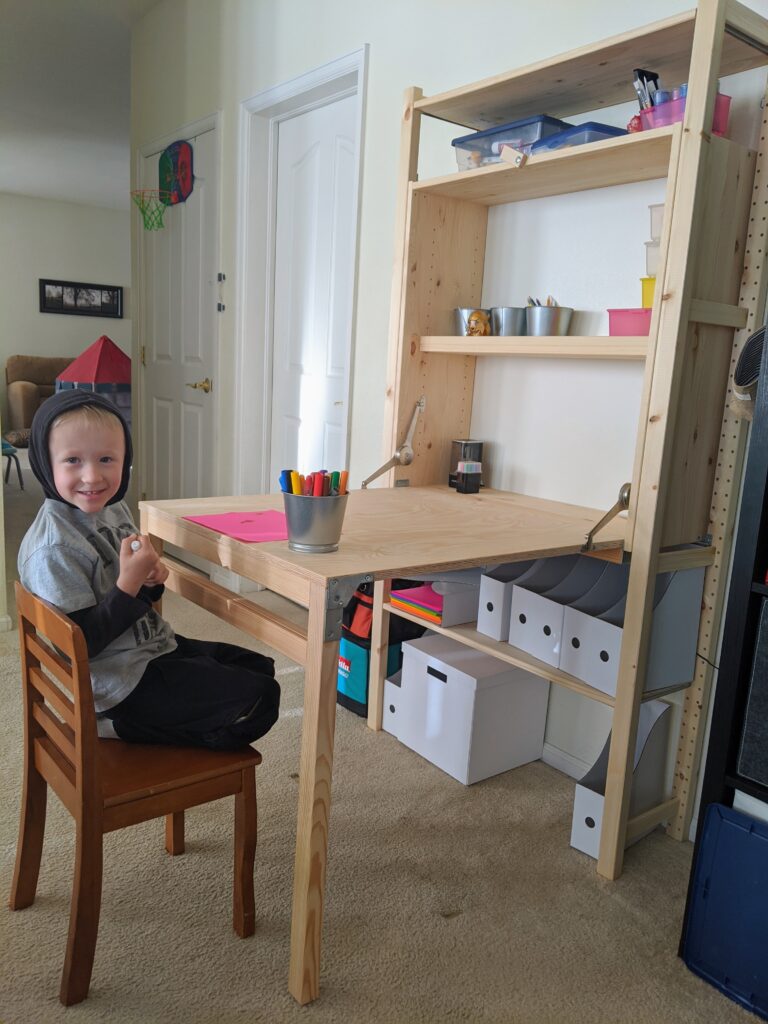
Tip 3: Stocking up on School Supplies
Before the kids go back to school, it’s crucial to stock up on essential school supplies. Make a list of items required by your children’s school and take advantage of back-to-school sales to save money. When shopping for supplies, involve your children in the process. Let them choose their preferred notebooks, folders, and backpacks, giving them a sense of excitement and anticipation for the new school year.

In addition to the basic school supplies, consider investing in organizational tools such as binders, folders, and planners to help your children stay organized throughout the year. Teach them how to use these tools effectively, emphasizing the importance of keeping track of assignments, due dates, and extracurricular activities.
By equipping your children with the necessary tools and teaching them organizational skills, you set them up for success in managing their academic responsibilities.

Amazon has some great back-to-school finds in their Back To School shop. It’s so helpful not having to run around to dozens of stores to find the proper colored college-ruled notebook or the correct-sized Trapper-Keeper (do they even use those anymore?).
Also, take the opportunity to assess the condition of your children’s backpacks, lunch boxes, and water bottles. Replace any worn-out or damaged items to ensure your children have reliable and functional gear for the school year. By stocking up on school supplies and ensuring your children have the necessary tools, you alleviate stress and set the foundation for a successful academic journey.
Also, don’t be afraid to check out places like Facebook Marketplace for budget finds. I love my kids, but let’s face it – Kids tear things and spill on things and lose things and generally destroy things at record speed. I always set alerts on Facebook Marketplace for certain items I’m looking for just in case they pop up so I can jump on them right away. Things like winter coats and snow boots are great to find second-hand. I’ve bought new or practically new items this way for a fraction of what I would have paid for otherwise.
Tip 4: Establishing a Morning Routine
The morning routine sets the tone for the entire day. Establishing a structured and efficient routine helps your children start their day on a positive note, ensuring they arrive at school on time and ready to learn. Begin by determining the time your children need to wake up to allow for a relaxed morning. Encourage them to set their own alarms and take responsibility for getting themselves out of bed. I recommend you start this routine at least two weeks before the school year begins to make sure they are used to getting up early for when classes start.
Tips to Help this Transition
We finally broke down this year and picked up these adorable Kids Echo Dots and Echo Glows (Prime Day for the win) so they are able to set their own alarms and take ownership of their morning routines. We found a time that everyone agreed upon based on what time school starts and how long it takes to get to school in the morning, and then they set the alarms and chose the alarm sound (important if you have a kid with sensitivities to certain sounds) in order for them to feel in control of their morning.
The Echo Glow enables us to schedule the light to turn on at a certain time (before their alarm goes off), and it slowly gets brighter to make for a much more gentle wake-up. That’s especially helpful in the winter months when it’s still dark when they are getting up.
Our kids have their wake-up routines set so after their alarm goes off, it tells them what the weather will be like and events on their calendar for the day.
Next, create a sequence of tasks that your child will need to complete each morning, such as brushing teeth, getting dressed, eating breakfast, and packing their school bags. Write down the routine and display it in a visible location, such as the refrigerator or the bathroom mirror. This visual reminder helps your children stay on track and ensures they don’t forget any essential tasks. (You can have Alexa remind them of those tasks too).
You can DOWNLOAD a FREE Simple Morning Routine Printable below.
It’s the perfect way to help your kids become more independent without having to nag about every little step while getting them ready to take on the day. They need to know how to get these things on their own, and this will help your child feel like they’ve got control over their day.
This also involves your children in the process. Ask your child what types of foods they would like for snacks a few weeks before school starts so when you are school shopping, you can pick out a few special snacks or treats to help the transition in getting them back to school (hey, I’m not above bribery). And more importantly, get them involved in preparing their own breakfast and packing their lunches.
Teach them simple and healthy meal options and encourage them to make choices within those options. By involving them in meal preparation, you not only teach them valuable life skills but also instill a sense of independence and responsibility.
Tip 5: Preparing Meals and Snacks in Advance
Preparing meals and snacks in advance is a game-changer when it comes to managing the chaos of the school year. Spending a little time each week to plan and prepare meals ahead of time saves you precious minutes during busy mornings and ensures your children eat a nutritious breakfast to get them through the day.
Start by creating a weekly meal plan that includes breakfast, lunch, and snacks. Get your children involved in the planning process, allowing them to choose their favorite meals and snacks from a pre-approved list. This not only gives them a sense of autonomy but also ensures they will enjoy the food and eat it willingly.
Download your own FREE Weekly Meal Planner Here.
Once you have a meal plan, dedicate a specific time each week to grocery shopping and meal preparation. Chop vegetables, cook grains, and pre-pack snacks in individual portions that are easy to grab on busy mornings. Consider investing in reusable containers or bento boxes to make packing lunches a breeze.
Tip 6: Creating a Family Calendar
A family calendar is an invaluable tool for staying organized and managing everyone’s schedules. Choose a central location, such as the kitchen or a command center, to display the calendar. Use a large whiteboard or a digital calendar that can be easily updated and accessed by all family members.
Involve your children in the process of adding their extracurricular activities, sports practices, and important dates to the calendar. This not only keeps them informed about their schedules but also teaches them the importance of time management and planning ahead and helps them feel more motivated throughout the week.
This Oversized Acrylic Dry Erase Calendar is great as it’s large enough to squeeze in all of your family’s activities or if you prefer a paper version, you can check out this Large Desk Calendar to keep your family’s schedule organized.
Additionally, encourage regular family meetings to review the calendar and discuss upcoming events or commitments. This ensures everyone is on the same page and allows you to make any necessary adjustments to accommodate everyone’s needs and priorities.
Tip 7: Implementing a Bedtime Routine
A consistent bedtime routine is essential for ensuring your children get enough sleep and wake up refreshed and ready for the day ahead. Establish a regular bedtime that allows for an adequate amount of sleep based on your children’s age. Encourage them to wind down in the evening by engaging in calming activities such as reading a book, taking a warm bath, or practicing relaxation techniques.
Limit the use of electronic devices before bedtime, as the blue light emitted by screens can interfere with sleep quality. Create a screen-free period before bed, during which your children can engage in quiet activities or enjoy some quality family time.
Download a copy of our Bedtime Routine Here
Furthermore, encourage your children to set aside what they want to wear the night before and pack their backpacks for the next day before bedtime. This helps them feel prepared and reduces morning stress. By implementing a consistent bedtime routine, you set the stage for restful sleep and a successful start to the next school day.
Helpful Tools for You and Your Student’s Safety
In situations where children might not be old enough for smartphones or where schools have restrictions on electronic devices, there are some smart watches on the market for kids for just this occasion. The Gabb Smart Watch is one that maintains communication while minimizing distractions. By incorporating features such as GPS tracking, an SOS button, and parental controls, the watch offers a reassuring safety net without encroaching on learning environments or overwhelming young users with unnecessary distractions. The Gabb Smart Watch generally gets compared to Verizon’s Gizmo Smart Watch, COSMO’s JrTrack Smart Watch, and TickTalk 4 Smart Watch which have similar features.
Things to Keep in Mind as you Prepare your Household for the First Day of School
- One of the best ways to get ready for the first day of school is to participate in the orientation/back-to-school night your school offers. This will allow you to raise any questions or concerns you have and let the teachers put a face to a name.
- At Orientation, you will usually also get the following information:
- Meet the school principal.
- Get a tour of the school building.
- If it’s available, having a map of your child’s school can be reassuring, in light of some of the scary situations we see in the news. It’s better to be safe than sorry.
- Find out what school clubs are offered to students.
- What ways you can get involved in school activities.
- What Things to Get for your child to help them be successful.
- Get Contact Information for your Child’s Teacher and the School Counselor.
- Save a copy of your Child’s schedule to reference so you are aware where they are throughout the day.
- If your child is involved in after-school activities, make sure you’ve got their coach and/or teacher’s contact information as well.
- At Orientation, you will usually also get the following information:
- Make sure you’re getting enough sleep too. Your kids aren’t the only ones getting burnt out with their new schedules.
- Your child might be a little overwhelmed for the first few weeks as they acclimate to their new schedule. Give them space. Give them grace.
Fast Tips
- Organize Supplies: Make a list of needed supplies and shop for essentials like notebooks, pens, and backpacks.
- Set Up a Schedule: Start adjusting sleep and wake times to get back into a school routine.
- Review Syllabus: Familiarize yourself with course outlines and expectations for the upcoming year.
- Prep Meals: Plan and prep easy and nutritious meals for busy school days.
- Check Uniform/Clothing: Ensure uniforms or appropriate clothing are ready for the new school year.
- Designate Study Space: Create a clutter-free study area with necessary materials and good lighting.
- Calendars and Planners: Get a calendar or planner to keep track of assignments, deadlines, and activities.
- Backup Devices: Ensure laptops or tablets are updated and backed up for virtual learning if needed.
- Stay Organized: Use folders, binders, or digital tools to keep notes and assignments organized.
- Positive Mindset: Approach the new year with a positive attitude and a willingness to learn and grow.
- Create a To-Do List: Make a list of tasks to complete before school starts, such as getting haircut, cleaning out your backpack, or organizing your desk.
- Check Technology: Ensure your devices, such as laptops, tablets, and calculators, are in working order and have the necessary software installed.
- Connect with Friends: Reconnect with old friends and make new ones by joining school clubs or attending orientation events.
- Health Check: Schedule a check-up with your doctor and make sure your vaccinations are up to date.
- Emergency Contacts: Update your emergency contact information at the school office or online portal.
- Review Goals: Set academic and personal goals for the year, whether it’s improving grades, joining a sports team, or learning a new skill.
- Time Management: Learn time management techniques to balance school, extracurricular activities, and personal time effectively.
- Study Strategies: Research and implement study techniques that work best for you, such as creating flashcards or using mnemonic devices.
- Prep for Projects: If you know about upcoming projects, start brainstorming ideas and gathering resources early.
- Practice Self-Care: Develop self-care routines, including exercise, meditation, or hobbies, to reduce stress and stay mentally healthy.
Remember, getting ready for back to school is not just about the physical preparations but also about setting yourself up for success mentally and emotionally.
Conclusion
Preparing your home for the back-to-school season is a crucial step in ensuring a smooth and successful start to the school year. By decluttering and organizing, creating a homework station, stocking up on school supplies, establishing morning and bedtime routines, and setting up designated study areas and family calendars, you create an environment that promotes focus, productivity, and harmony. Remember to involve your children in the process, empowering them to take ownership of their responsibilities and develop important life skills. With careful planning and organization, you can set your family up for a successful and enjoyable school year.